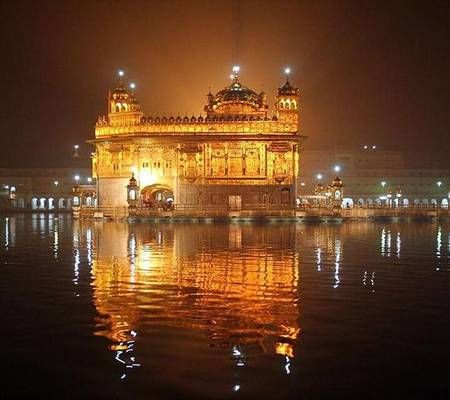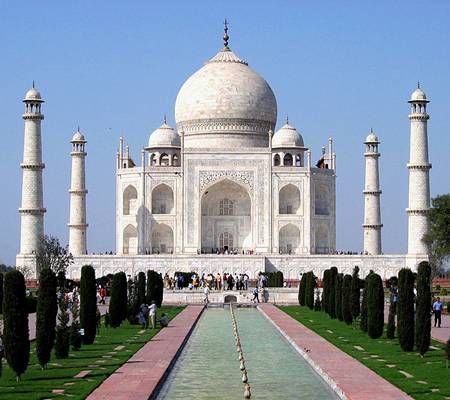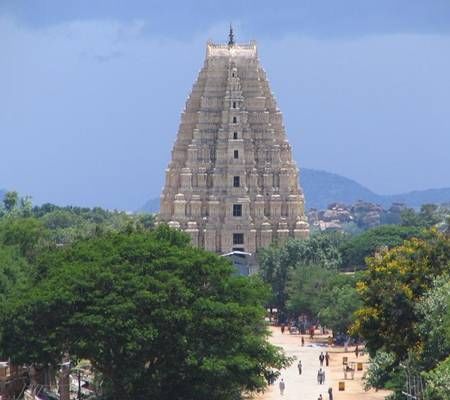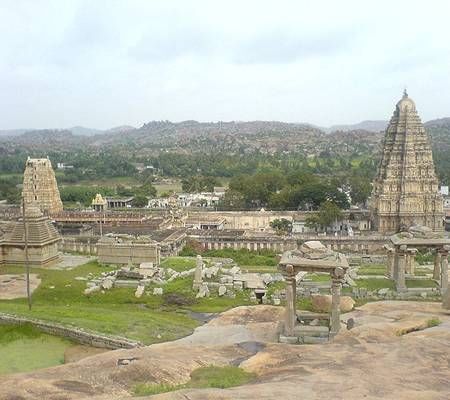|
Kathie Shayne
|
 |
« on: January 19, 2010, 03:23:08 AM » |
|
1.Shravanabelagola or Gomateshwara

The 17.8 m monolith of Jain prophet Bhagavan Gomateshwara Bahubali, which was carved out around 983 C.E and is located in Shravanabelagola, India, is anointed with saffron every 12 years by thousands of devotees as part of the Mahamastakabhisheka festival. The colossal monolithic statue of Gomateshwara (Shravanabelagola is a synonymous word), also called as Bahubali the Jain saint, created around 983 C.E by Chamundaraya, a minister of the Ganga King, Rachamalla (Raachmalla SathyaVaak IV 975-986 C.E) is located atop the Chandragiri hill (618 steps climb leads to the monolith on the hill), near the town of Shravanabelagola in Karnataka state. This statue is said to have been carved out of a single block of fine-grained white granite and is considered of great religious significance because Jains believe Bahubali was the first to attain moksha (freedom from cycle of birth and death). The image stands on a lotus. It has no support up to the thighs and is 60 feet (18 m) tall with the face measuring 6.5 feet (2.0 m). The statue is completely in the nude, in the Jain custom and is visible from a distance of 30 km.With the serene expression on the face of the image, its curled hair with graceful locks, its proportional anatomy, the monolith size, and the combination of its artistry and craftsmanship have led it to be called the mightiest achievement in sculptural art in medieval Karnataka. It is the largest monolithic statue in the world.
The neighbouring areas of Shravanabelagola, apart from the Gomateshwara statue, have Jaina bastis and several images of the Jaina Thirthankaras. A beautiful view of the surrounding areas could be seen from the top of the Chandragiri hill. Every 12 years, thousands of devotees congregate here to perform the Mahamastakabhisheka, a spectacular ceremony in which the thousand-year-old statue is anointed with milk, curds, ghee, saffron and gold coins. The anointing last took place in February 2006, and the next ceremony will occur in 2018.
|
|
|
|
|
|
Kathie Shayne
|
 |
« Reply #1 on: January 19, 2010, 03:24:25 AM » |
|
2. Golden temple or Harmandir Sahib
|
|
|
|
|
|
Kathie Shayne
|
 |
« Reply #2 on: January 19, 2010, 03:25:43 AM » |
|
The Harmandir Sahib (The abode of God) – Golden Temple (main building) Complex with Akal Takht Sahib.completed in August 1604 AD
The Harmandir Sahib (Punjabi) or Darbar Sahib, informally referred to as the Golden Temple or Temple of God, is culturally the most significant shrine of the Sikhs and one of the oldest Sikh Gurudwara. It is located in the city of Amritsar, which was established by Guru Ram Das, the fourth guru of the Sikhs and the city that it was built in, is also due to the shrine known as Amritsar.
The fourth Guru of Sikhism, Guru Ram Das, excavated a tank in 1577 C.E which subsequently became known as Amritsar or Amrit Sarovar (meaning: Pool of the Nectar of Immortality), giving its name to the city that grew around it. In due course, a splendid Sikh edifice, Harmandir Sahib (meaning: The abode of God) [6], rose in the middle of this tank and became the supreme centre of Sikhism. Its sanctum houses the Adi Granth, compiled by Guru Arjun Dev, comprising compositions of Sikh Gurus and other saints considered to have Sikh values and philosophies e.g. Baba Farid, Kabir, etc. . Devotees, for whom the temple is a symbol of freedom and spiritual independence, come here from all over the world to enjoy its environs and offer their prayers. The Golden Temple sits on a rectangular platform, surrounded by a pool of water called the Amrit Sarovar. The temple building has four entrances instead of the usual single entry. This is symbolic of the openness of Sikhism and indicates that followers of all faiths are allowed inside. The walls within are decorated with carved wooden panels and elaborate inlay work in silver and gold. The Adi Granth, rests on a throne beneath a jewel-encrusted canopy. Priests conduct continuous recitation of verses from the holy book.
|
|
|
|
|
|
Kathie Shayne
|
 |
« Reply #3 on: January 19, 2010, 03:28:22 AM » |
|
03. Taj MahalTaj Mahal, built in the memory of the queen Mumtaz Mahal[/color]  Taj Mahal (also "the Taj"), the pinnacle of Mughal architecture, * Archeological Survey of India description was built by the Mughal emperor Shah Jahan in memory of his queen Mumtaz Mahal. It is considered the finest example of Mughal architecture, a style that combines elements from Persian, Turkish, Indian, and Islamic architectural styles. In 1983, the Taj Mahal became a UNESCO World Heritage Site and was cited as "the jewel of Muslim art in India and one of the universally admired masterpieces of the world's heritage." It is an integrated symmetric complex of structures that was completed around 1648. Ustad Ahmad Lahauri is generally considered to be the principal designer of the Taj Mahal. Taj Mahal (also "the Taj"), the pinnacle of Mughal architecture, * Archeological Survey of India description was built by the Mughal emperor Shah Jahan in memory of his queen Mumtaz Mahal. It is considered the finest example of Mughal architecture, a style that combines elements from Persian, Turkish, Indian, and Islamic architectural styles. In 1983, the Taj Mahal became a UNESCO World Heritage Site and was cited as "the jewel of Muslim art in India and one of the universally admired masterpieces of the world's heritage." It is an integrated symmetric complex of structures that was completed around 1648. Ustad Ahmad Lahauri is generally considered to be the principal designer of the Taj Mahal.
The focus of the Taj Mahal is the white marble tomb, which stands on a square plinth consisting of a symmetrical building with an iwan, an arch-shaped doorway, topped by a large dome. Like most Mughal tombs, basic elements are Persian in origin. The base structure is a large, multi-chambered structure. The base is essentially a cube with chamfered edges and is roughly 55 meters on each side (see floor plan, right). On the long sides, a massive pishtaq, or vaulted archway, frames the iwan with a similar arch-shaped balcony. On either side of the main arch, additional pishtaqs are stacked above and below. This motif of stacked pishtaqs is replicated on chamfered corner areas as well. The design is completely symmetrical on all sides of the building. Four minarets, one at each corner of the plinth, facing the chamfered corners, frame the tomb. The main chamber houses the false sarcophagi of Mumtaz Mahal and Shah Jahan; their actual graves are at a lower level. The exterior decorations of the Taj Mahal are among the finest to be found in Mughal architecture. The calligraphy found are of florid thuluth script, created by Persian calligrapher Amanat Khan.
Masons, stonecutters, inlayers, carvers, painters, calligraphers, dome-builders and other artisans were requisitioned from the whole of the empire and also from Central Asia and Iran to build the monument. While bricks for internal constructions were locally prepared, white marble for external use in veneering work was obtained from Makrana in Rajasthan. Semi-precious stones for inlay ornamentation were brought from distant regions of India, Ceylon (SriLanka) and Afghanistan. Red sandstone of different tints was requisitioned from the neighbouring quarries of Sikri, Dholpur. It took 17 years for the Taj to be built.
|
|
|
|
|
|
Kathie Shayne
|
 |
« Reply #4 on: January 19, 2010, 03:29:21 AM » |
|
04. HampiVijayanagar Raja Gopura at Hampi, Karnataka  The 14th century ruins nestle within them with almost every highlight of classical Indian architecture. Palaces, temples, marketplaces, watch towers, stables, baths and monoliths lie scattered amidst huge boulders, which complement the rugged look and historic feel of the place.[/color]
|
|
|
|
|
|
Kathie Shayne
|
 |
« Reply #5 on: January 19, 2010, 03:31:04 AM » |
|

Ruins of Hampi - UNESCO World Heritage Site, presents the Vijayanagara architecture, a vibrant combination of the Chalukya, Hoysala, Pandya Chola styles, idioms that prospered in previous centuries. It Hampi was the last capital of the Vijayanagar Empire, which was admired by the travellers between the 14th and 16th centuries. But it was pillaged and abandoned by the Muslim confederacy which conquered the Decann in 1565 C.E. Palaces, temples, marketplaces, watch towers, stables, baths and monoliths lie scattered amidst huge boulders, which complement the rugged look and historic feel of the place.
Its legacy of sculpture, architecture and painting influenced the development of the arts long after the empire came to an end. Its stylistic hallmark is the ornate pillared Kalyanamantapa (marriage hall), Vasanthamantapa (open pillared halls) and the Rajagopura (tower). While the empire's monuments are spread over the whole of Southern India, nothing surpasses the vast open air theatre of monuments at its capital at Vijayanagara.Go to The NEXT Page for More Pictures >>> |
|
|
|
|
|
 IMAGE CORNER
IMAGE CORNER Wallpapers/Cool Images
Wallpapers/Cool Images Nature / Scenic Beauty
Nature / Scenic Beauty The Seven Wonders Of India
The Seven Wonders Of India IMAGE CORNER
IMAGE CORNER Wallpapers/Cool Images
Wallpapers/Cool Images Nature / Scenic Beauty
Nature / Scenic Beauty The Seven Wonders Of India
The Seven Wonders Of India
